An introduction to the practice and use of light emitting diodes to create fields of multi colored light. Fade and switching circuits and devices to control numerous LED’s are described. The use of miniature optical devices and certain organic materials as wave guides are given as examples of successfully completed works of art making use of LED’s and other electronic and optical components.
We are all familiar with the work of the French pointillist painters. The pointillist artists purposely used specific monochromatic bits of color applied in small color cells—each color so close together that the eye mixes or blurs the separate colors, creating a third intermediary color. Different people see Seraut’s paintings in ‘different’ colors because no two people mix observed colors the same way. Color video monitors create colors much the same way, by ‘mixing’ three closely spaced monochromatic colors – R_G_B – the intensity of the colors in the cell determine the hue or color given off by the cell. Jumbotrons and other large format video monitors use LEDs, neon tubes and high intensity discharge lamps to create similar three color cells, electronically activated to simulate color and movement.
The monochromatic light emitted by most LED’s appears grainy when magnified, not unlike the “speckle” associated with laser light. If an LED is magnified and projected onto a screen, this ‘grainieness’ exhibits itself as speckle. When light from LED’s of several different wavelengths is overlaid, one on the other, an interesting thing happens, very subtle hues and values develop of not just the monochromatic original colors, but an infinite range of ‘in between’ colors. Our eyes have sensed and mixed the colors. Taking advantage of this apparent mixing of colors, a image or stream of text can seem to appear and disappear as colors change as individual LED’s brighten and dim. The light emitted is monochromatic, power consumption is low and little heat is generated by the generation of the light. By varying supply voltage and focus, an unlimited variety of intensity and range is possible. The subtlety of wash effects available is so great, that surface texture in combination with highly oblique angles of projection can produce painterly like techniques of surface color application.
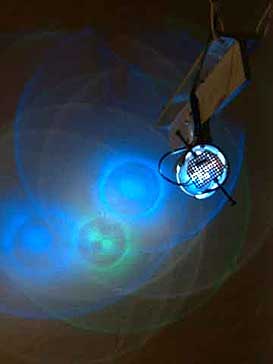 My earliest work with light emitting diodes was as light sources for projected works of art. The driver circuits were mounted so that the LED’s became the actual object of projection. By placing the LED at the point of focus, and varying the intensity of individual LED’s I was able to create abstract color field wall pieces. These works of art were first exhibited at Ringsted, Denmark in 2001. Other exhibitions followed, using LED and incandescent sources. All of these works made use of focal plane illuminated light sources as the projected media. It soon became apparent that LED’s in combination with some sort of translucent projection media offered an infinite variety of potential works of art.
My earliest work with light emitting diodes was as light sources for projected works of art. The driver circuits were mounted so that the LED’s became the actual object of projection. By placing the LED at the point of focus, and varying the intensity of individual LED’s I was able to create abstract color field wall pieces. These works of art were first exhibited at Ringsted, Denmark in 2001. Other exhibitions followed, using LED and incandescent sources. All of these works made use of focal plane illuminated light sources as the projected media. It soon became apparent that LED’s in combination with some sort of translucent projection media offered an infinite variety of potential works of art.
All LED’s have a semi conductor interface. This is the source of the emitted light. Any semi conductor electronic device creates some sort of light like radiation. The interaction of the materials that make up the two to three point junction referred to as a semi conductor interface, creates cascades of electrons and photons. This occurs when power is applied to the device. This radiation can range from far infrared to short wave ultraviolet. As in all radiant devices, the electron and photon cascade is depended on the type of atomic material and to some extent the energy source used to create the excited state. In semi conductor devices not intended as light sources, this cascade of electrons and protons becomes a way to change, amplify, modify or switch voltages. In light emitting diodes, the package protecting the semi conductor interface is transparent, and the cascade, if in visible light, can be observed. The first practical visible light LED’s were red. As with lasers, another photon cascade device, the long wavelengths of visible and non visible light were the first to be successfully created and observed. Semi conducting lasing devices are built by creating resonate semi-conducting “chambers” that allow a similar batch or bundle of photons to be created and emitted in discrete time bundles.
An LED is a two point semi conductor, a transistor a three point semi conductor device. A transistor can function as a switch or as a voltage modulation device, an LED as a one way gate, voltages of certain ranges can only go one way through an LED. By using these devices together with appropriate support electronics, such as resistors, capacitors and condensers the intensity of the light output of the LED can be varied. If another micro electronic device is added, a so called “chip”, then variations on timing of the dimming and brightening can be effected. Circuitry can be designed for desired displays and an almost infinite variety of circuitry is available ready made. A control circuit I commonly work with can control and illuminate as many as 1500 LED’s at one time. Extremely high output light emitting diodes can be used as miniature projectors. The heat output of the light source is so low ink jet or laser print transparencies can be used as projection media.
Appendix
The circuit below is a simple color fade circuit that can drive up to six LED’s of moderate power. The 100k resistor can be replaced with a variable resister that allows the modification of the fade decay rate for the circuit.
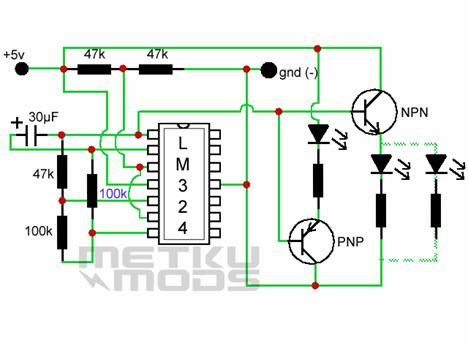
The circuit below is available as a kit from www.bigclive.com located in Scotland. This is a very durable device, capable of driving 1500 LED’s.
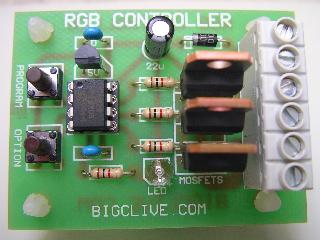
Light Emitting Diodes are available form many sources. Some of the most interesting are manufactured by CREE. Their web site is CREE.com. Various suppliers offer CREE as well as other LED’s. The illustration shows the typical CREE package.

A more typical device is shown here. The color output of the LED is determined by the type of material used in the semiconductor layer, not the external resin package
.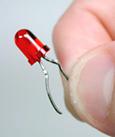
 This illustration is of LED’s directly wired to “hearing aid” batteries. The tiny batteries were taped between the leads of the LED. The power output of the battery is low enough that the circuit is self ballasting, no resistor is need. This gives an idea of the great variety of LED’s available.
This illustration is of LED’s directly wired to “hearing aid” batteries. The tiny batteries were taped between the leads of the LED. The power output of the battery is low enough that the circuit is self ballasting, no resistor is need. This gives an idea of the great variety of LED’s available.
John Powell
Light Time in Space, Inc.
101 Franklin Street
Allston, Massachusetts
lighttimeinspace.com lighttimeinspace@verizon.net
Light through transparent colours
Decomposition of colour images to symmetric and antisymmetric components
The scholarly foundations for this claim© originate not just from philosophy, but partly from the method of mathematical description applied to quantum physics: the operators describing the world’s physical phenomena can always be broken down into a symmetrical and an antisymmetric component. This follows from the fact that our physical operators can mathematically be represented by matrices, and matrices possess this mathematical characteristic.
It would be one-sided for us to force the approach of physics onto our view of the world. Neither is there any need. The method can be extended. This has been done by the method patented by Gy. Darvas®, 2003. Everything that can be represented by points arranged in matrix-like fashion – the grid points of a crystallized material, the pixels of a digital image, etc. – can be broken down (with the use of specialized scale transformation procedures) into symmetric and antisymmetric components along its arbitrary axis of symmetry, if the elements of the matrix used are formed such that the value of a quantifiable characteristic attributed to the given points is applied to them (e.g. the colour intensity codes of the given pixel, etc.). For definition, by the antisymmetric pair of an image point we mean the point of complementary colour (marked by the complementary colour code) that appears at the respective opposite point as reflected in or rotated twofold around an arbitrary axis. As a result, everything that can be depicted pictorially can be broken down into symmetrical and antisymmetrical components. (This is the basis for the author’s method patented in 2003.) For we really do “see”, “watch” and “observe” the world with the sockets of our retinas, and our retinas forward the information, as image point codes separated by colour, to the respective part of our brain responsible for processing and interpreting images. (Applications for black-and-white images, see in Darvas, 2003³.)
The two parts of the picture artificially divided into symmetrical and antisymmetrical components reproduce the original when projected onto one another. The antisymmetric image component displays the deviations from symmetry of the original image. This is the basis for the technological applications made possible by this method.
If we copy the symmetrical and antisymmetrical images seen in Figure 1 and 2 onto transparent material and place one on top of the other, we are given a reproduction of the original. In Figure 3 we can see which (asymmetric) work of art we split into two image components, each in itself hard to identify with the original. The method can be performed with any picture: all images can be assembled from a symmetrical and an antisymmetrical component.
© Darvas, G. (2007) Symmetry, Basel: Birkhäuser, xi + 508 p.
® Darvas Gy. (2003) Antiszimmetrikus-szimmetrikus összetevőkre bontáson alapuló képfeldolgozó eljárás, Image processing based on dismounting into antisymmetric-symmetrtic components. P0302597 Magyar Szabadalmi Hivatal.
³ Darvas, G. (2003) Symmetry-antisymmetry, quasiperiodicity, and a classification of gauge invariances, Symmetry: Culture and Science, 14-15, 21-35.
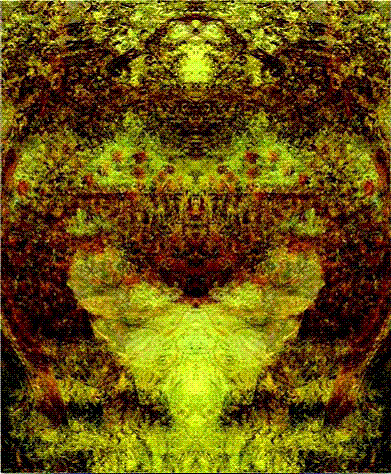 |
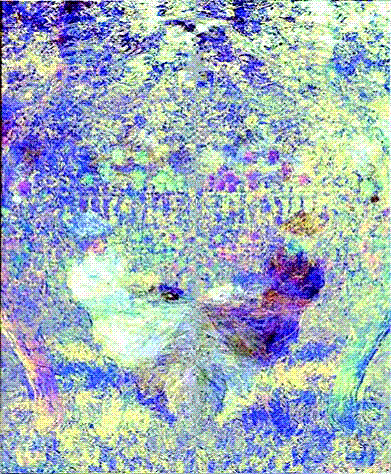 |
| Figure 1: Symmetrical image | Figure 2: Antisymmetrical image |
| on the two sides of the perpendicular mirror axis, the colour of the respective mirror points is | |
| identical | complementary |
|
To summarize, with the help of this light-and-colour transformation, assisted by a computer program, we can say that according to our present knowledge asymmetry is the synthesis of symmetry and antisymmetry. A world view, that can compete as much with the Tao and the learning of the Confucians, as also with the traditional European philosophies. 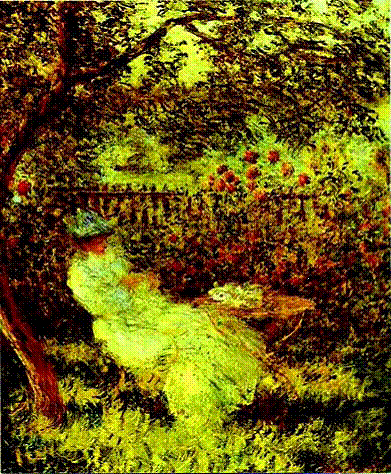
Figure 3: C. Monet: Alice Hoschedé in the Garden (1881) |
|